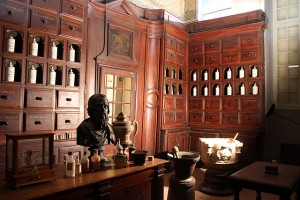Changes in the Medical Field
Changes within the roles of medical practitioners

Université d’Avignon Ancienne pharmacie Sainte-Marthe
by CamilleStromboni, used under 
During the 1700’s there was a shift in the way that various medical roles were viewed and the roles of those individuals. Apothecaries were often dealt with herbs and made remedies for certain ailments that might be prescribed by physicians or were given through unofficial diagnoses to those unable to afford the fees of a physician’s diagnosis. Physicians were often individuals with training and often only dealt with internal issues or illnesses. If there were other external ailments, such as broken bones or pulling teeth, surgeons would handle this. However as the roles of each position changed it became increasingly important to define who did what. At this time physicians lost some of their ability to prescribe remedies and thus the role of apothecaries increased in importance (Eamon, 2005).
As the century progressed, the roles continues to develop and change. The use for a general surgeon was becoming increasingly important as there were locations where was impractical to have multiple medical persons. A general practitioner was trained and practiced various aspects of each medical area (Eamon, 2005).
Advances in the medical field
As British colonies were established, they looked to their home country for current medical practices. Even as British medical journals kept the colonies updated and current on medical practices, the practitioners noticed that there were environmental differences that required local discoveries and advances. As the colonists worked with the natives they learned local remedies and cures to ailments and diseases. With these discoveries, the colonists exposed the natives to deadly diseases they had never experienced before. The diseases changed the relationships with the colonists and transformed the demography of the native culture (Medicine, 2003).
The colonies continued to follow Britain and made changes in the ability of an individual’s medical practice. With the changing times, different colonies enacted legislation that limited the fees of medical practitioners, regulated education of practitioners and also regulated the role of practitioners. Changed continued through the American Independence War and during this time Medical Boards were formed that regulated accreditation and practitioners (Medicine, 2003).
Important individuals
During this time of change and transition, there were two individuals who were vital to the advancement of medical thinking and the medical field. Hermann Boerhaave and Georg Ernst Stahl each had different views of the body and how it worked that were used to gain a better understanding of how the body works. Both were university professors but were also scientists interested in how the body worked. Boerhaave thought of the body as a system of fluids while Stahl believed this system of chemistry could not fully explain the body.

United States National Library of Medicine-Old location
by Center for Disease Control, used under ![]()
Stahl believed in the difference of living and non living things. Today we know that neither was fully correct but neither was either fully incorrect. These professors led the eighteenth century in medical advances. Beyond those individuals, Boerhaave’s student Julien Offroy de La Mettrie lead the way in philosophical thinking and took Boerhaave’s ideas to an extreme that saw medicine as fundamental to the reformation of society, Albrecht von Haller started his studies of the nervous system in this century, John Hunter and Pieter Camper led studies that looked at animals’ bodies and compared them to humans, and William Cullen and Boissier de Sauvages were leaders in the classification of many diseases (Medicine, 2003).
Even with the many studies and discoveries through the century, there was not a lot of change in the way that patients were handled or cared for (Medicine, 2003). It was not until many years later that the new discoveries, including that of smallpox, would lead to a change in patient care (Medicine, 2003).
These discoveries can be attributed as revolutionary for many reasons. One, there were conflicting opinions about the body and this led to controversy. Two, there was not a lot of change with the new discoveries meaning some people suffered from the lack of implementation after a discovery was made. Third, and perhaps most important, the changes happened through the years and are still continuing today. Today, the ideas that were explored in the 1700’s are used today to start new studies. There are many things about the body that have yet to be discovered and in this way, the dramatic discoveries made in the 1700’s are still impacting the way medicine is practiced today.
Sources
CamilleStromboni (2012, December 12). Université d’Avignon Ancienne pharmacie Sainte-Marthe. [Digital Image]. Retrieved from http://commons.wikimedia.org/wiki/File:Universit%C3%A9_d%27Avignon_Ancienne_pharmacie_Sainte-Marthe.jpg. Available under Creative Commons Attribution 2.0.
Center for Disease Control. (n.d.). Old location of National Library of Medicine, Washington, D.C. [Digital Image]. Retrieved from http://commons.wikimedia.org/wiki/File:United_States_National_Library_of_Medicine-Old_location.jpg. Public domain image.
Eamon, M.(2005). Medicine. In Britain and the Americas: Culture, politics, and history. Retrieved from https://ezproxy.butler.edu/login?qurl=http%3A%2F%2Fsearch.credoreference.com%2Fcontent%2Fentry%2Fabcbramrle%2Fmedicine%2F0
Medicine. (2003). In Science in the enlightenment: An encyclopedia. Retrieved from https://ezproxy.butler.edu/login?qurl=http%3A%2F%2Fsearch.credoreference.com%2Fcontent%2Fentry%2Fabcscienl%2Fmedicine%2F0
Recent Comments